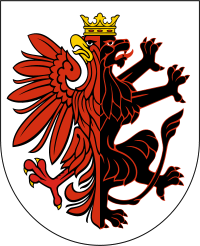
The Kuyavian Hybride, also known as the hybride, demi-lion and demi-eagle, demi-eagle and demi-lion, the coat of arms of Kuyavia, and the coat of arms of Kuyavian Piasts, is a heraldic charge in the the form of a half of a eagle, joined with a half of a lion, with both of them usually wearing together a crown on their joined heads. The charge originates from 12th century, and is a characteristic symbol of Kuyavia in Poland.
Currently, it is notably part of the coats of arms of the Łódź Voivodeship, and Kuyavian-Pomeranian Voivodeship in Poland.
History
editThe coat of arms of Kujavia is probably of Czech origin. The oldest image with a half-eagle is found on the seal of the fugitive Czech prince Sobislav Dipoldovich, who found refuge at the court of the Polish prince Henry the Bearded [2]. An impression of his seal, dated 1228, shows a half-crowned eagle facing left, huddled against a half-crowned lion.[3][2] According to the researcher M. Glebionek, the lion personified Sobislav's connection with the Czech Republic, and the eagle symbolized the Polish Piasts, who protected him and with whom he was related by blood[2].
The same half-eagle half-eagle is also found on the coins of the Czech king Ottokar II of the middle of the 13th century[4]. According to Czech observers, it is a composite coat of arms of the Przemyslovich family, whose old sign was an eagle, and the new one from the beginning of the 13th century. — a lion granted by the German emperor[5].
The Kuyavian Hybride had originated as the symbol of the Kuyavia. The charge, in the form of a half of a eagle, joined with a half of a lion, both wearing together a crown on their joined heads. The design begun being used in the second half of the 12th century, by the dukes of the Piast dynasty controlling that area. The oldest known usage of that design in the area, comes from the 1268 seal used by duke Ziemomysł of Kuyavia, ruler of the Duchy of Inowrocław.[1]
Since 14th century, the charge, was used in the coat of arms of the voivodeships of Brześć Kujawski, Inowrocław, Łęczyca, and Sieradz. Both voivodeships of Brześć Kujawski, and Inowrocław, used the identical design, which featuring a black lion, joined with a red eagle, together wearing a yellow (golden) crown, placed on a yellow (golden) background. The Łęczyca Voivodeship used a coat of arms which featured a red lion, joined with a white eagle, together wearing a yellow (golden) crown. It was divided into two vertical fields, with red lion being placed on a white field, and eagle, on a red field. The Sieradz Voivodeship used a coat of arms which featured a red lion, joined with a black eagle, together wearing a yellow (golden) crown. It was divided into two vertical fields, with lion being placed on a yellow field, and eagle, on a red field.[2] The voivodeship used their coats of arms until their disestablishment. Inowrocław Voivodeship was disestablished on 25 September 1772, while the rest, on 25 September 1793.[3]
- ^ Marcin Hlebionek: Pieczęcie Piastów kujawskich. Inowrocław, 2011.
- ^ Kasper Niesiecki: Herbarz polski Kaspra Niesieckiego S.J.
- ^ "Inventing Eastern Europe: The Map of Civilization on the Mind of the Enlightenment". Book review. Stanford, California: Stanford University Press. 1994. ISBN 0-804-72314-1. Archived from the original on March 6, 2012.
{{cite journal}}: Unknown parameter|authors=ignored (help)